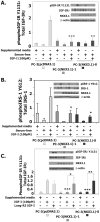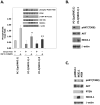NKX3.1 activates expression of insulin-like growth factor binding protein-3 to mediate insulin-like growth factor-I signaling and cell proliferation
- PMID: 19258508
- PMCID: PMC3740340
- DOI: 10.1158/0008-5472.CAN-08-3022
NKX3.1 activates expression of insulin-like growth factor binding protein-3 to mediate insulin-like growth factor-I signaling and cell proliferation
Abstract
NKX3.1 is a homeobox gene that codes for a haploinsufficient prostate cancer tumor suppressor. NKX3.1 protein levels are down-regulated in the majority of primary prostate cancer tissues. NKX3.1 expression in PC-3 cells increased insulin-like growth factor binding protein-3 (IGFBP-3) mRNA expression 10-fold as determined by expression microarray analysis. In both stably and transiently transfected PC-3 cells and in LNCaP cells, NKX3.1 expression increased IGFBP-3 mRNA and protein expression. In prostates of Nkx3.1 gene-targeted mice Igfbp-3 mRNA levels correlated with Nkx3.1 copy number. NKX3.1 expression in PC-3 cells attenuated the ability of insulin-like growth factor-I (IGF-I) to induce phosphorylation of type I IGF receptor (IGF-IR), insulin receptor substrate 1, phosphatidylinositol 3-kinase, and AKT. The effect of NKX3.1 on IGF-I signaling was not seen when cells were exposed to long-R3-IGF-I, an IGF-I variant peptide that does not bind to IGFBP-3. Additionally, small interfering RNA-induced knockdown of IGFBP-3 expression partially reversed the attenuation of IGF-IR signaling by NKX3.1 and abrogated NKX3.1 suppression of PC-3 cell proliferation. Thus, there is a close relationship in vitro and in vivo between NKX3.1 and IGFBP-3. The growth-suppressive effects of NKX3.1 in prostate cells are mediated, in part, by activation of IGFBP-3 expression.
Figures





Similar articles
-
The inhibitory effects of NKX3.1 on IGF-1R expression and its signalling pathway in human prostatic carcinoma PC3 cells.Asian J Androl. 2012 May;14(3):493-8. doi: 10.1038/aja.2011.158. Epub 2011 Dec 19. Asian J Androl. 2012. PMID: 22179513 Free PMC article.
-
Restoration of insulin-like growth factor binding protein-related protein 1 has a tumor-suppressive activity through induction of apoptosis in human prostate cancer.Cancer Res. 2003 Nov 15;63(22):7717-23. Cancer Res. 2003. PMID: 14633696
-
Overexpression of insulin-like growth factor binding protein-5 helps accelerate progression to androgen-independence in the human prostate LNCaP tumor model through activation of phosphatidylinositol 3'-kinase pathway.Endocrinology. 2000 Jun;141(6):2257-65. doi: 10.1210/endo.141.6.7520. Endocrinology. 2000. PMID: 10830316
-
Insulin-like growth factors and insulin-like growth factor binding proteins in the endometrium. Effect of intrauterine levonorgestrel delivery.Hum Reprod. 2000 Aug;15 Suppl 3:173-81. doi: 10.1093/humrep/15.suppl_3.173. Hum Reprod. 2000. PMID: 11041233 Review.
-
Nuclear localization and actions of the insulin-like growth factor 1 (IGF-1) system components: Transcriptional regulation and DNA damage response.Mutat Res Rev Mutat Res. 2020 Apr-Jun;784:108307. doi: 10.1016/j.mrrev.2020.108307. Epub 2020 Feb 27. Mutat Res Rev Mutat Res. 2020. PMID: 32430099 Review.
Cited by
-
Antitumor activity and immunogenicity of recombinant vaccinia virus expressing HPV 16 E7 protein SigE7LAMP is enhanced by high-level coexpression of IGFBP-3.Cancer Gene Ther. 2014 Mar;21(3):115-25. doi: 10.1038/cgt.2014.6. Epub 2014 Feb 21. Cancer Gene Ther. 2014. PMID: 24556712
-
Loss of PTEN Accelerates NKX3.1 Degradation to Promote Prostate Cancer Progression.Cancer Res. 2019 Aug 15;79(16):4124-4134. doi: 10.1158/0008-5472.CAN-18-4110. Epub 2019 Jun 18. Cancer Res. 2019. PMID: 31213464 Free PMC article.
-
IGFBP-3 is a metastasis suppression gene in prostate cancer.Cancer Res. 2011 Aug 1;71(15):5154-63. doi: 10.1158/0008-5472.CAN-10-4513. Epub 2011 Jun 22. Cancer Res. 2011. PMID: 21697285 Free PMC article.
-
IGFBP3 modulation of tumor pathogenesis and cell signaling pathways (Review).Oncol Lett. 2025 Jun 3;30(2):379. doi: 10.3892/ol.2025.15125. eCollection 2025 Aug. Oncol Lett. 2025. PMID: 40503041 Free PMC article. Review.
-
Antioxidant treatment promotes prostate epithelial proliferation in Nkx3.1 mutant mice.PLoS One. 2012;7(10):e46792. doi: 10.1371/journal.pone.0046792. Epub 2012 Oct 15. PLoS One. 2012. PMID: 23077524 Free PMC article.
References
-
- Swalwell JI, Vocke CD, Yang Y, et al. Determination of a minimal deletion interval on chromosome band 8p21 in sporadic prostate cancer. Genes Chromosomes Cancer. 2002;33:201–5. - PubMed
-
- Bowen C, Bubendorf L, Voeller HJ, et al. Loss of NKX3. 1 expression in human prostate cancers correlates with tumor progression. Cancer Res. 2000;60:6111–5. - PubMed
-
- Asatiani E, Huang WX, Wang A, et al. Deletion, methylation, and expression of the NKX3. 1 suppressor gene in primary human prostate cancer. Cancer Res. 2005;65:1164–73. - PubMed
-
- Voeller HJ, Augustus M, Madlike V, et al. Coding region of NKX3. 1, prostate-specific homeobox gene on 8p21, is not mutated in human prostate cancers. Cancer Res. 1997;57:4455–9. - PubMed
-
- Ornstein DK, Cinquanta M, Weiler S, et al. Expression studies and mutational analysis of the androgen regulated homeobox gene nkx3. 1 in benign and malignant prostate epithelium. J Urol. 2001;165:1329–34. - PubMed
Publication types
MeSH terms
Substances
Grants and funding
LinkOut - more resources
Full Text Sources
Molecular Biology Databases
Research Materials
Miscellaneous

